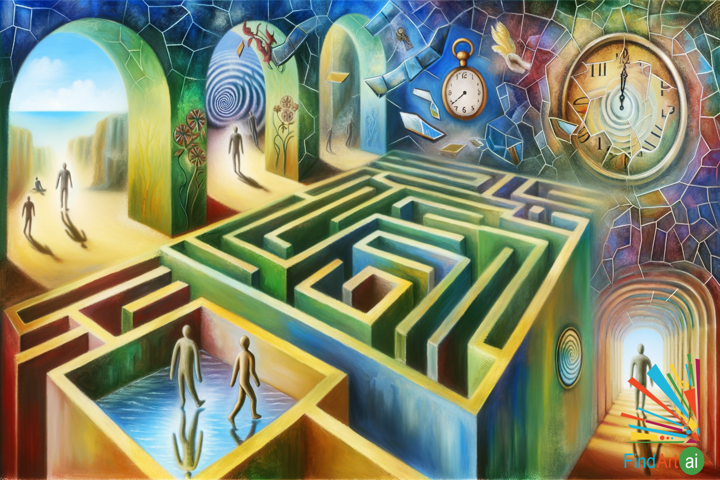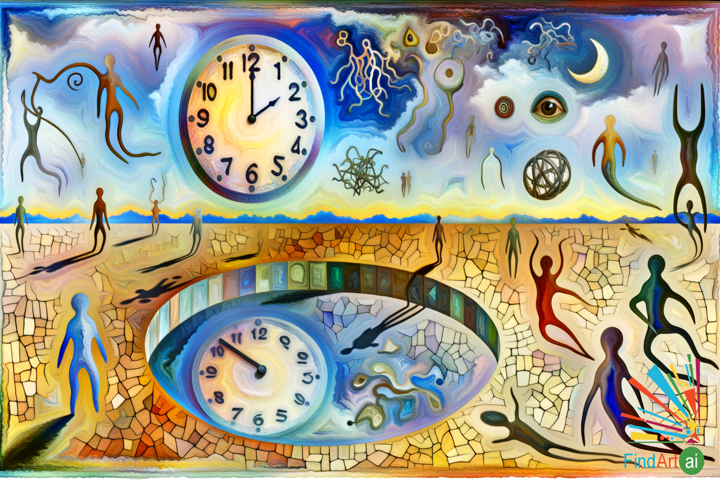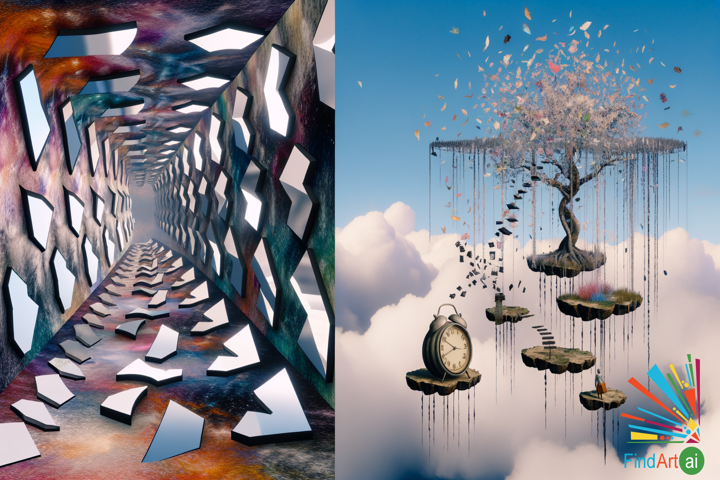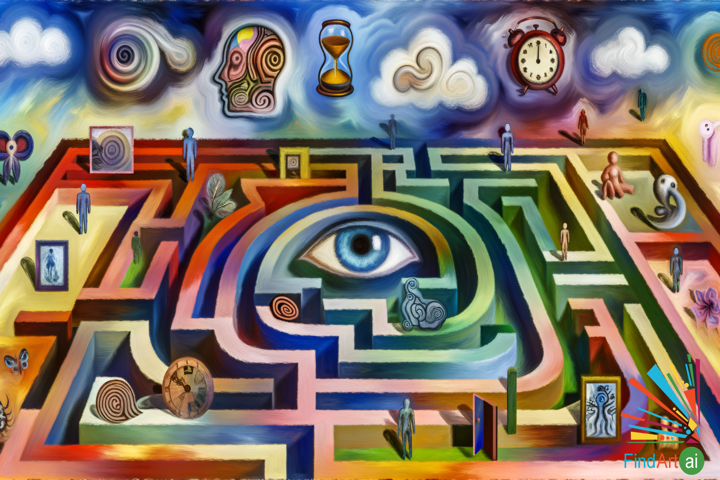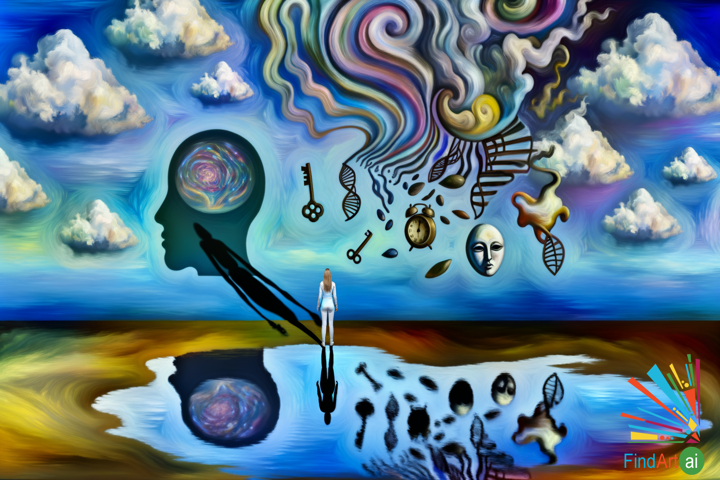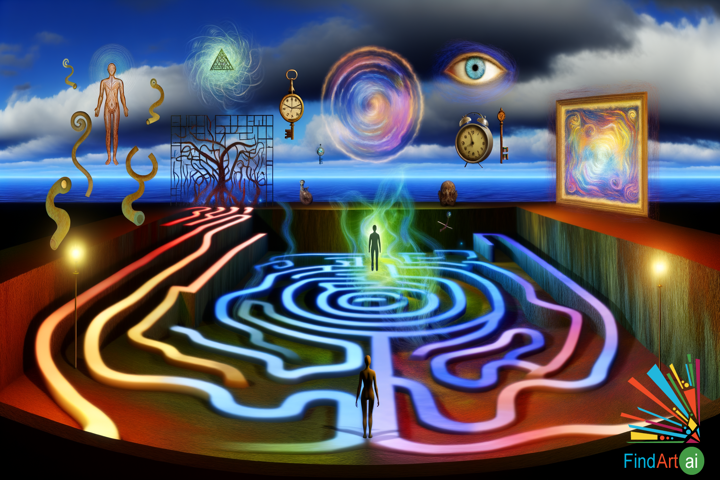
Surrealism Paintings with Psychological Exploration Theme
Surrealism Paintings with the Psychological Exploration theme delve into the depths of the human mind, presenting inner emotions, desires, fears, and subconscious thoughts through symbolic, dreamlike imagery. These works aim to uncover hidden aspects of the psyche, inspired by Freudian and Jungian ideas about the unconscious. Through distorted forms, unexpected juxtapositions, and evocative symbolism, Surrealist artists create visual representations of psychological states, bridging the gap between the conscious and unconscious mind.
Key Characteristics of Surrealism Paintings with Psychological Exploration Theme
- Dreamlike and Irrational Imagery
- Paintings often depict scenes that feel like dreams or hallucinations, where logic and natural laws are suspended, reflecting the unpredictable nature of the subconscious.
- Example: A barren desert landscape may feature a solitary figure with a keyhole for a face, symbolizing the search for hidden knowledge or identity.
- Symbolic Representations of Inner States
- Surrealists use metaphors and symbols to express complex psychological concepts such as anxiety, desire, or repression.
- Example: A painting might show a figure weighed down by chains attached to floating balloons, symbolizing the conflict between freedom and restriction.
- Fragmentation and Distortion
- Figures and objects may appear fragmented, stretched, or morphed, representing fractured or layered aspects of the mind.
- Example: A human form could dissolve into a swirl of colors or shapes, illustrating the dissolution of identity or the merging of conscious and unconscious thoughts.
- Juxtapositions of the Familiar and the Strange
- Ordinary objects and settings are combined with surreal elements to create unsettling yet meaningful contrasts, emphasizing the mind's layered complexity.
- Example: A serene family dinner might include an oversized eye watching from the ceiling, hinting at hidden fears or suppressed emotions.
- Exploration of Repressed Desires
- Influenced by Freud, many Surrealist works focus on taboo or suppressed feelings, presenting them in abstract or symbolic forms to reveal their psychological impact.
- Example: A locked box in a painting might represent forbidden thoughts, with tendrils of light escaping to suggest their eventual emergence.
- Personal and Archetypal Themes
- Paintings may explore individual psychological struggles or universal archetypes, drawing from myth, folklore, or shared human experiences.
- Example: A recurring figure, such as a shadowy double, might represent the "shadow self" or repressed aspects of the personality.
- Ambiguous Atmosphere
- The tone of these paintings often lies between fascination and unease, reflecting the beauty and complexity of exploring the unknown aspects of the mind.
- Example: A peaceful garden with unsettling, faceless figures can evoke both calm and discomfort, mirroring the dual nature of self-exploration.
Common Themes in Psychological Exploration
- The Duality of Self
- Paintings often explore the contrast between one’s outer persona and hidden inner emotions or thoughts.
- Example: A portrait where half the face is serene and the other half dissolves into chaotic lines, symbolizing inner turmoil.
- Fear and Anxiety
- Works frequently depict abstract representations of fear, such as endless corridors or looming shadows, capturing the feeling of dread without explicitly showing the source.
- Example: A labyrinth filled with closed doors might symbolize feelings of entrapment or confusion.
- Desire and Longing
- Surrealist works often depict human desires in exaggerated or surreal forms, exploring their subconscious origins.
- Example: A figure reaching toward a glowing object just out of reach could symbolize unattainable aspirations.
- The Passage of Time
- The concept of time is often portrayed as fluid or irrelevant, reflecting the mind's non-linear nature.
- Example: A clock melting over a tree branch, as in Salvador Dalí’s The Persistence of Memory, symbolizes the malleability of time in dreams and memory.
- Childhood Memories and Trauma
- Many Surrealist works explore early experiences or unresolved emotional conflicts, often depicted as surreal and fragmented.
- Example: A toy placed in an eerie, empty landscape might represent the lingering influence of childhood on the adult psyche.
Surreal Labyrinth: Exploring the Mind's Pathways Through Symbolic Art
A surrealist painting delves into the human psyche with a central labyrinth symbolizing the mind's p...
Surrealist Labyrinth: Exploring the Psyche with Symbols, Emotions, and Dreamlike Imagery
A surrealist painting explores the human psyche through a dreamlike labyrinth, each corridor reflect...
Explore a Surreal Landscape: Mirror Paths & Floating Islands of the Psyche
Enter a surreal landscape, a gateway to the human mind's depths. A mirror path reflects emotions, le...
Surreal Painting: An Abstract Labyrinth of the Human Psyche with Clocks, Mirrors, and Doors
Create a surreal painting exploring the human psyche. An abstract labyrinth symbolizes mind facets—m...
Surreal Landscape: A Labyrinth of Shadows, Time, Secrets, and Identity
In a surreal painting, a figure stands by a vast, reflective lake, its shadow forming a labyrinth of...
Dreamscape Labyrinth: A Journey Through Identity, Emotions, and Psyche's Fluidity
In a dreamscape where consciousness blurs with the subconscious, a figure stands at a labyrinth's en...

